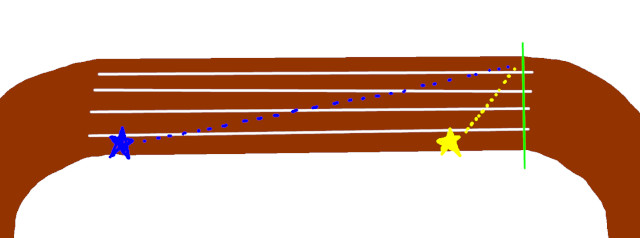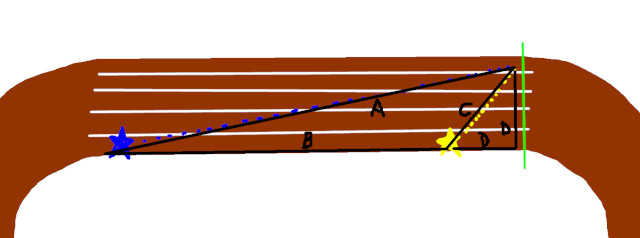Cut Over Slowly
Jun
8
2022
We have reached the end of the track season here, and one of the later meets reminded me of something that I feel like posting today. On certain events – I think this one was the 4×800 relay – the first 1.25 laps will have the runners stay in their lanes, but then on the back straightaway they are allowed to move over to lane 1. And there is usually an official standing at that point to both make sure people don’t cut over too early and also to remind them to cut over.
My experience as someone who understood math was that I did not cut over very quickly. And that frustrated the official, who thought I didn’t hear him yelling “Cut over!”, so he yelled more and louder at me.
Even all these years later, not many high school kids realize how much extra they are running. They just know that lane 1 is the shortest lane and thus they want to get to it as soon as they can.
It looks like this (not to scale, wrong number of lanes, other disclaimers):

The yellow star is where most runners aim to get, and the blue star is where I was aiming to get, and the green line is the start of the back stretch when runners could leave their lanes.
And now I’m going to add some geometry.

As you see, the distance I ran was line segment A, and other runners were choosing B+C.
Now let’s put some numbers in.
It doesn’t look like it, but the yellow dashed line is supposed to be a 45 degree angle. A standard high school track has 8 lanes of 42 inches each, so segment D is 28 feet
D2 + D2 = 1568, the square root of which is 39.6, so C = 39.6 feet.
Segment B is going to be 100 meters – 28 feet, so we end up with 300 feet.
Now for segment A. The Pythagorean theorem only works with right triangles, so this one is a little trickier. It’s also not enough just to know two length, we need an angle also.
Since I made angle CD to be 45, I know that BC is 135. So now we’re stuck using the Law of Cosines. I was hoping it would be easier, but that’s what I got.
A2 = B2 + C2 – 2BC cos(A)
A = sqrt(90000 + 784 – 2*8400*cos(135))
A = 320 feet
So I would run 320 feet, and the opposition would run 339.6 feet, so I would get an advantage of 19.6 feet.
Your mileage may vary, especially if you’re not always in lane 8. And yes, it should be 7 lanes of width because no one runs on the outside of the lane so the 42 inches of lane 8 should be discounted. I’ll let you run the math on what the more appropriate number is. Just consider the 19.6 as the highest value it could be. Also, the opposition was not also in lane 8 with me, so no their distance would not be from the same point I was, as shown on the diagram (for illustrative purposes only).
Then it happened, when the Philistine came closer to meet David, that David ran quickly toward the battle line to meet the Philistine.
1 Samuel 17:48




This little article thingy was written by Some Guy sometime around 6:00 am and has been carefully placed in the Sports category.

 This is Alpha, the first-born, when he was 2YO.
This is Alpha, the first-born, when he was 2YO. This is Beta, the second-born, when he was about 2YO.
This is Beta, the second-born, when he was about 2YO. This is Gamma, the third-born, when he was about 18MO.
This is Gamma, the third-born, when he was about 18MO.


June 12th, 2022 at 11:56 pm
There was a similar thing at Youngstown. The track for the PT test was a meandering path along the edge of some trees, 1/2 mile total (the PT test is 1.5 miles, so three laps). At some places it weaves back and forth a bit. I ran along the inside of each swerve, trying to make my trajectory as straight as possible. The person timing me said no one else does that; everyone else followed the curve of the path.
41.2669751199978, -80.67012361784211
It doesn’t look as pronounced from the aerial shot. But running it, it felt like a pretty big difference. I bet the distance is measured from the center of the path, so after three times around, I wonder how much shorter I ended up running.